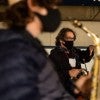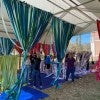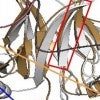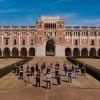

Under the instruction of Rice Symphonic Band Director Chuck Throckmorton, Hanszen College senior José Corea plays his saxophone through a mask at Rice Stadium on a sunny spring day.

A new class of Community Bridges Fellows is stepping beyond the classroom and into the community through the program run by Rice’s Kinder Institute fo...

Two student teams from Rice have been named finalists in the 2025 Collegiate Inventors Competition, a program by the National Inventors Hall of Fame....

Scientists from Rice and Houston Methodist have developed a new way to reduce inflammation in the brain, a discovery that could help fight diseases su...

Through temporary installations and an expanding permanent collection, the Moody Center for the Arts brings thought-provoking art into spaces where st...

Rice will serve as the official host institution for the 2026 NCAA Men’s Basketball Regional at the Toyota Center, the NCAA announced this week....

The Rice-Houston Methodist Digital Health Institute will host an inaugural summit Oct. 8 at Rice, launching what will become an annual gathering at th...

Rice climatologist Sylvia Dee has been awarded the 2025 Nanne Weber Early Career Award from the American Geophysical Union’s Paleoceanography and Pale...

Richard Gordon, the W.M. Keck Foundation Professor of Geophysics in Rice’s Department of Earth, Environmental and Planetary Sciences, has been awarded...

Carrie Masiello, the W. Maurice Ewing Professor of Biogeochemistry at Rice, has been elected a fellow of the American Geophysical Union, the world’s l...

The 22nd annual Rice Alliance Energy Tech Venture Forum saw 50 ventures pitch their companies to a full crowd of investors and corporate leaders Sept....

The Rice football team is off to a historically great start following a 28-17 win last week against the University of North Carolina at Charlotte....

No. 25 Rice rallied from an early deficit to defeat Grambling State 3-1 on a rainy Sunday afternoon at Holloway Field in the Owls' non-conference fina...

Under the instruction of Rice Symphonic Band Director Chuck Throckmorton, Hanszen College senior José Corea plays his saxophone through a mask at Rice Stadium on a sunny spring day.

Dutch artist collective We Make Carpets supervised the installation of its latest site-specific piece on campus from the Netherlands via Zoom as masked-up Rice community members tied yards of colorful ribbon to 6-foot lengths of pipe for “Barn Raising.”

Rice student to play for nationwide audience on 'Performance Today'
Graduate student in horn performance Lauren Anker will represent Rice's Shepherd School of Music as part of American Public Media’s “Performance Today” Young Artists in Residence series. Her segments will be posted online March 25.

Rice Stadium to become community vaccination site
The facility has already begun vaccinating some Rice students, faculty and staff — by appointment only — as part of a “soft launch” before ramping up full operations next week.

Eddie Glaude on the moment the ‘cold civil war’ turned hot
The Princeton professor's Campbell Lecture on March 4 tackled the stakes of racial justice and the future of American democracy.

Nicole Lennon kills it on and off the court at Rice
Maria Garza-Lennon recruited Rice long before her daughter Nicole was recruited to be a volleyball player for the Owls.

Rice announces plans for 2021 Commencement
President David Leebron, Provost Reginald DesRoches, Dean of Undergraduates Bridget Gorman and Dean of Graduate and Postdoctoral Studies Seiichi Matsuda sent a message to the Rice community March 5 regarding 2021 Commencement plans.

Cancer ‘guardian’ breaks bad with one switch
A mutation that replaces a single amino acid in a potent tumor-suppressing protein makes it prone to nucleating amyloid fibrils implicated in many cancers as well as neurological diseases.

Study aims to help governments maximize profits from oil and gas auctions
Federal and state governments auction leases to oil and gas companies to extract natural resources from public land. A revamp of the auction system — utilizing a new model developed by a Rice University economist — could lead to more competitive bids and, ultimately, more money for governments.

Rice Crisis Management Team honored by Board of Trustees
The Rice Board of Trustees honored the university's Crisis Management Team (CMT) for its extraordinary work during the last year.